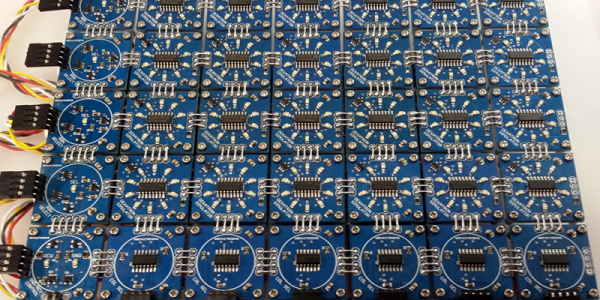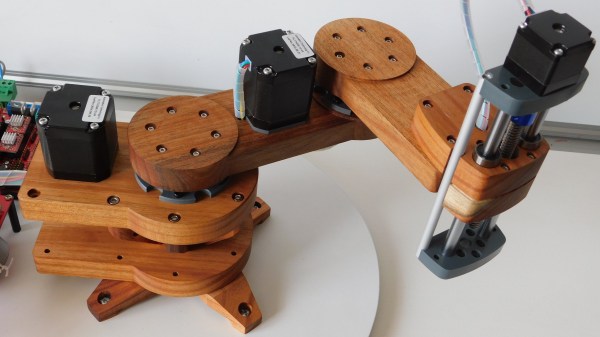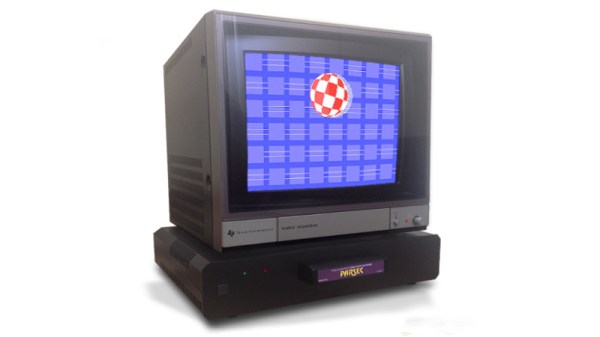A large hacker camp is in microcosm a city, it has all the services you might expect to find in a larger settlement in the wider world. There is a telecommunication system, shops, bars, a health centre, waste disposal services, a power grid, and at some camps, a postal system. At Electromagnetic Field, the postal system was provided by the Sneakernet, a select group of volunteers including your Hackaday scribe under the direction of the postmaster Julius ter Pelkwijk. I even had the fun of delivering some chopped pork and ham. (More on that later.) Continue reading “My Career As A Spammer, And Other Stories From The Sneakernet”
Month: September 2018
Packing 10 Into 1: A Square Inch Dekatron Replacement
One of the things that always attracts our eye in old movies is how many kinds of displays you see on old gear both real and imaginary. Really old stuff usually had meters or circular recorders. But slightly newer movies often had some kind of exotic digital display with Nixes or Numitron tubes. One of the really exotic display devices was a Dekatron. While these are pretty rare, you can make a stand-in using modern LEDs and [Dave] did just that in an entry into our square inch competition.
These were gas-filled tubes with ten positions. You had to reset the tube and then the tube would visibly count pulses providing a visual indicator from zero to nine. Depending on the tube configuration, you could use them to count or to act as a divider. Those with neon fill looked sort of orange, although there were argon-based ones that had a purple glow. You can see what an older version of the board looks like in the video below or skip to the second video if you want to see the real ones in action.
Continue reading “Packing 10 Into 1: A Square Inch Dekatron Replacement”
The DIN Rail And How It Got That Way
Unless you’ve spent some time in the industrial electrical field, you might be surprised at the degree of integration involved in the various control panels needed to run factories and the like. Look inside any cabinet almost anywhere in the world, and you’ll be greeted by rows of neat plastic terminal blocks, circuit breakers, signal conditioners, and all manner of computing hardware from programmable logic controllers right on to Raspberry Pis and Arduinos.
A well-crafted industrial control panel can truly be a thing of beauty. But behind all the electrical bits in the cabinet, underneath all the neatly routed and clearly labeled wires, there’s a humble strip of metal that stitches it all together: the DIN rail. How did it come to be, and why is it so ubiquitous?
Tesla Opens With Precomputed Key Fob Attack
This clever precomputation attack was developed by a group of researchers at KU Leuven in Belgium. Unlike previous key fob attacks that we’ve covered in the past which have been essentially relay attacks, this hack precomputes a ton of data, looks for a collision in the dataset, and opens the door. Here’s how it works.
Continue reading “Tesla Opens With Precomputed Key Fob Attack”
Wood Shines In This SCARA Robotic Arm Project
[igarrido] has shared a project that’s been in the works for a long time now; a wooden desktop robotic arm, named Virk I. The wood is Australian Blackwood and looks gorgeous. [igarrido] is clear that it is a side project, but has decided to try producing a small run of eight units to try to gauge interest in the design. He has been busy cutting the parts and assembling in his spare time.
Besides the beautifully finished wood, some of the interesting elements include hollow rotary joints, which mean less cable clutter and a much tidier assembly. 3D printer drivers are a common go-to for CNC designs, and the Virk I is no different. The prototype is driven by a RAMPS 1.4 board, but [igarrido] explains that while this does the job for moving the joints, it’s not ideal. To be truly useful, a driver would need to have SCARA kinematic support, which he says that to his knowledge is something no open source 3D printer driver offers. Without such a driver, the software has no concept of how the joints physically relate to one another, which is needed to make unified and coherent movements. As a result, users must control motors and joints individually, instead of being able to direct the arm as a whole to move to specific coordinates. Still, Virk I might be what’s needed to get that development going. A video of some test movements is embedded below, showing how everything works so far.
Continue reading “Wood Shines In This SCARA Robotic Arm Project”
TI(ny) Is A New Take On The TI-99/4A
Way back in the 1980s, in the heyday of the personal computer revolution, Texas Instruments were one of the major players. The TI-99/4A was one of their more popular machines, selling 2.8 million units after an epic price war with the Commodore VIC-20. However once it had been discontinued, fans were left wanting more from the platform. Years later, that led [Fabrice] to produce the TI(ny), his take on an upgraded, more integrated TI-99/4A (Google Translate link).
Having spent many years working on these machines, [Fabrice] was very familiar with the official TI schematics – regarding both their proper use and their errors, omissions and inaccuracies. With a strong underlying knowledge of what makes a TI-99/4A tick, he set out to pen his own take on an extended model. [Fabrice] rolls in such features as Atari-compatible joystick ports, slot connectors for PeBOX expansion cards, and an RGB video output. It’s then all wrapped up in a very tidy looking case of somewhat unclear construction; it appears to be modified from an existing small computer case, and then refinished to look almost stock.
The best detail, though? It’s all made with components available in 1983! We see a lot of retro builds that are the equivalent of throwing a modern fuel-injected V8 into a vintage muscle car, and they are fantastic – but this is a project that shows us what was possible way back when.
Overall it’s a tidy build that shows what the TI-99/4A could have been if it was given a special edition model at the end of its life. If you’re looking to relive the glory days of the machine yourself, what better way then firing up the best demo on the platform? As the saying goes – Don’t Mess With Texas.
[Thanks to g_alen_e for the tip!]
Unphotogenic Lighting As A Feature
Have you ever taken a picture indoors and had unsightly black bars interrupt your otherwise gorgeous photo? They are caused by lighting which flickers in and out in its normal operation. Some people can sense it easier than others without a camera. The inconsistent light goes out so briefly that we usually cannot perceive it but run-of-the-mill camera phones scan rows of pixels in sequence, and if there are no photons to detect while some rows are scanned, those black bars are the result. Annoying, right?
What if someone dressed that bug of light up as a feature? Instead of ruining good photos, researchers at the University of California-San Diego and the University of Wisconsin-Madison have found out what different frequencies of flicker will do to a photograph. They have also experimented with cycling through red, green, and blue to give the effect of a poorly dubbed VHS.
There are ways an intelligent photographer could get around the photo-ruining effect with any smartphone. Meanwhile DSLR cameras are already immune and it won’t work in sunlight, so we are not talking about high security image protection. The neat thing is that this should be easy to replicate with some RGB strips and a controller. This exploits the row scanning of new cameras, so some older cameras are immune.

















